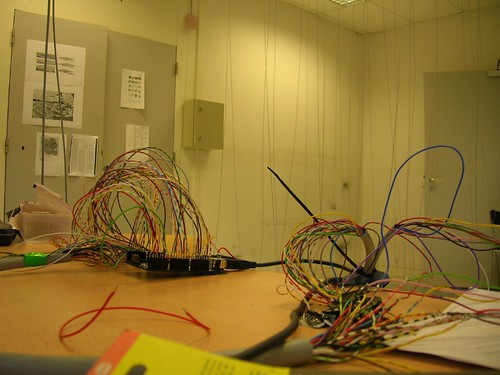A more structured summary of what I found interesting at the Crystalpunk workshop for soft architecture in Utrecht last week-end:
- Pablo Miranda's talk targeted two aspects of architecture: being critical and projective. As for the critique part, a lot of things in architecture comes from the assumption that one can do stuff by drawing (before, people were building directly). The use of computer application has complicated this situation: new tools (3ds max, maya, catia...) gives a very important flavor to what's been designed: so who is going to be the author of a project built using such a tool? the architect or the designers of the tool? Concerning the projects, he presented those of his group which are amazingly interesting, especially those playing with genetic algorithm in architecture.
- Adam Somlai-Fischer's point was about 'bionic spaces", not smarthomes. Sdam is against smarthomes, makes you dumb and incapable to interact with reality (which I definitely agree with, I hate the crappy intelligent fridge idea that may be refilled when empty). For him, architecture is not the building itself, not the behavior, it's not a dress code BUT the idea that space that surrounds us is a responsibility AND it's a social process. He thinks that now that social software are paving this way (web2.0, flickr...), we have familiar ground to replicate this in architecture. He then presented his incredible projects.
- Jelle Feringa elaborated on Pablo's critique about interactive architecture. For him, each architect style is bound to the software they used (marcus novak - mathematica /greg lynn - maya kas oosterhuis - virtools / frank gehry - catia). His critique was also that specific software designed for architects are regressive. For example piranesi is very limitative: the software creates romantic-sketchy-cheesy models that make architects bound to old-fashioned model to create architecture. For him, archiCAD is also regressive in the sense that it helps quickly resolve design dilemmas and site-constraints unique tu strict municipal-building codes and client requirements through its interactive abilities. One of the most interesting project he presented was a chair design produced with genetic algorithm. They started by asking a question: "what is the minimum volume defining a chair" which they try to answer using genetic algorithm techniques. For Jelle, this was a new way of designing by addressing a specific question before creating an artifact.
- Jonas Hielscher (Z-25) presented his project Dat-a: an installation based on RFID technology. The dat-a project allows to track people in an exhibit using rfid (you can see people's name in different rooms). He said: "we are in effect creating and Internet of Things". He and Pablo also mentioned this interesting fact after my presentation about blogject: we will get enormeous piles of data, how would we do deal with that (data mining gets hot as Jonas said).
Thanks Wil for all of this!
